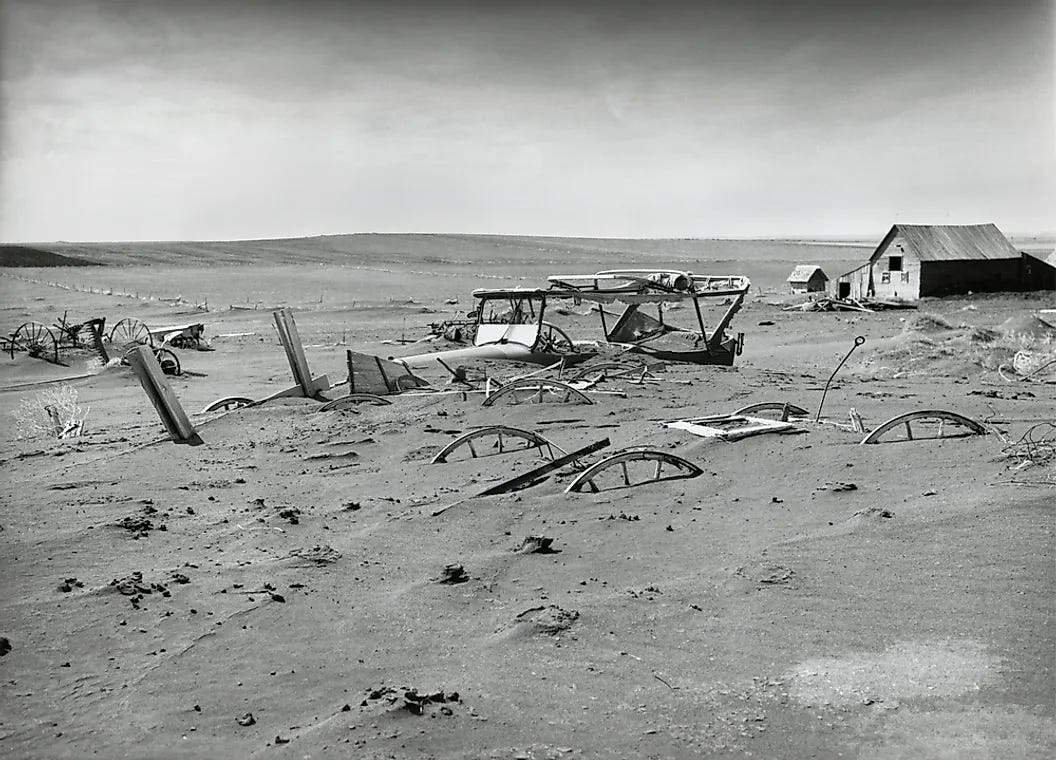Ricochet is the best place on the internet to discuss the issues of the day, either through commenting on posts or writing your own for our active and dynamic community in a fully moderated environment. In addition, the Ricochet Audio Network offers over 50 original podcasts with new episodes released every day.
 Are Climate Cultists Ignoring History?
Are Climate Cultists Ignoring History?
I love history and historians. Not all, but many, like my friend Dr. Alvin Felzenberg, whose classes at the University of Pennsylvania or Yale University he would occasionally invite me to guest lecture. Felzenberg is the author of many terrific books, including “The Leaders We Deserved (And A Few We Didn’t).” It is an incomparable survey and grading of US presidents from George Washington through George W. Bush.
As Secretary of the US Senate, I was also responsible for the Senate’s Historical Office, ably led during my tenure by the legendary Dr. Richard Baker and later by Dr. Don Ritchie. He gave me the best US Capitol tour I’ve tried replicating for almost 30 years. You’ve likely seen both remarkable historians on the networks.
They all have one great trait in common. They are magnificent storytellers.
But today, my friends take a back seat to Brad Belk.

I’ve never met Belk. He’s the “community historian” at Missouri Southern University in Joplin. But he penned an op-ed for the Joplin Globe about a weather incident from 1954 that makes me appreciate a few consecutive days of 95+ degree weather here in Northern Virginia (we’ve yet to hit the 100-degree mark this summer).
Local historians do great deep dives into local events. Belk does here:
The summer of 1954 will be remembered for the scalding heat reaching an astounding high of 122 degrees on July 14 in Pittsburg, Kansas. The searing heat lasted for 52 days, beginning in mid-June and continuing through Aug. 7. Forty-five days the mercury indicated 100 degrees or better. Over 25 of those days, the mercury broke 105 degrees. Temperature recordings were collected from daily newspaper reports from The Pittsburg Headlight.
Pittsburg led the region by suffering 11 days of 110 degrees or better. Three of those days Pittsburg received national recognition for leading the country in being the hottest spot in America.
The summer of 1954 was a result of a heavy mass of hot, dry air settling over much of the Midwest. The air’s origin was from Arizona and New Mexico. The brutal heat and extreme drought conditions continued because this broiling, arid system simply refused to budge.
The heat wave of 1954, coupled with a drought of almost three years, caused at least 83 of the 418 Kansas communities with municipal water supplies to impose some sort of restrictions on water use, according to the State Board of Health.
The shortage of water the cities and towns experienced in 1954 was largely due to the lack of wells, the scant supply of distribution facilities and an insufficient amount of surface water. The lack of wells and lack of distribution facilities were simply cases of shortsightedness, because by 1950 the consumer demand for water had increased. In 1930, water use averaged about 50 to 60 gallons per person, per day; by 1950, a resident of Kansas used a daily average of about 135 gallons of water.
Remember that air conditioning was around for the few who could afford it. It wasn’t anywhere near as prevalent as today, not to mention city and county water systems.
Belk’s op-ed focuses on just one event he was probably around to experience. There have been others. Many others.
But that hasn’t stopped lunatics and propagandists in the media from their usual fear-mongering. Like this lovely headline in the uber-lefty Texas Monthly: “Is This a Typical Texas Heat Wave or the Coldest Summer of the Rest of Our Lives?” Or this, from MIT Technology Review: “Do these heat waves mean climate change is happening faster than expected?” Or maybe this will send you screaming into your basement, triple-masked and quadruple-boosted, from Reuters: “Explainer: How climate change drives heatwaves and wildfires.”

Let’s revisit the Great Depression and Dust Bowl year of 1936, as told by Gizmodo.com, on one of the seven most miserable heat waves in history:
JUNE 1936
June of 1936 saw unusual heat build initially in two nodes, one centered over the Southeast and another over the Rocky Mountains and western Plains. This differs from the current heat wave that began mostly over Texas and the Deep South.
By the end of June 1936 all-time state monthly records for heat had been established in Arkansas (113° at Corning on June 20th), Indiana (111° at Seymore on June 29th), Kentucky (110° at St. John on June 29th), Louisiana (110° at Dodson on June 20th), Mississippi (111° at Greenwood on June 20th), Missouri (112° at Doniphan on June 20th), Nebraska (114° at Franklin on June 26th), and Tennessee (110° at Etowah on June 29th). A total of 8 states and all these monthly records are still standing.
JULY 1936
By July the dome of heat locked in place over the central and northern Great Plains and remained there for the entire month.
Around July 8-10 the ridge briefly extended all the way to the East Coast when virtually every absolute maximum temperature record was broken from Virginia to New York. This held true for most sites in the Ohio Valley, Upper Midwest, and Great Plains as well. There are so many superlatives that it is impossible to list them all. In short the following states broke or tied their all-time maximum temperatures that July:
Add to the above list a 120° reading at Gann Valley, South Dakota on July 5th…
On July 15th the average high temperature for all 113 weather stations in Iowa measured 108.7°. Similar to the current heat wave the nighttime low temperatures were also remarkably warm. Bismarck recorded a low of just 83° on July 11th. Milwaukee, Wisconsin endured five consecutive nights above 80° from July 8-13. Even near the normally cool shores of Lake Erie amazing temperatures were recorded such as the low of 85° and high of 110° at Corry, Pennsylvania on July 14th. And most amazing of all was the low of 91° at Lincoln, Nebraska on the night of July 24-25th warming to an all-time record of 115° on the 25th.
Residents of Lincoln, Nebraska spend the night on the lawn of the state capital on July 25, 1936. The temperature that night never fell below 91°, perhaps the warmest night ever recorded anywhere in the United States outside of the desert Southwest.
AUGUST 1936
By August the heat dome shifted a bit further south from its position over the northern Plains and became anchored over the southern Plains.
Of course, climate cultists will quickly trot our statistics that purport to demonstrate an increase in “extreme” weather events since the Industrial Revolution of the 19th Century. And they’re only going to get worse, they promise.
They won’t mention perhaps the most cataclysmic drought and heat wave of . . . wait for it. . . 1540. They didn’t measure CO2 back then, but I bet it was less than now. The world’s population was about 500 million compared to 7 billion today. And factories weren’t a thing.
Even the far-left Daily Kos (a propaganda outfit affiliated with MoveOn.org) couldn’t ignore studies of the severe conditions in Europe in 1540:
South of the Alps the disaster started in 1539. By October processions supplicating God for rain were being conducted in Spain, and an Italian chronicle describes the winter weather as being as dry and warm as in July. The drought spread north early in 1540; an Alsatian vintner noted that there were only three days of rain in March. The soil dried out and cracked; according to one chronicle, you could dangle your legs in some of the fissures. This resulted in a positive feedback cycle that stabilized the heat wave: less water available for evaporation meant less cooling of the air and hence more drying out of the soil.
And the heat wave was ferocious. The number of days with temperatures over 30°C (86°F) was at least three times as great as usual. Wells and springs dried up that had never done so before. A Swiss chronicler reported that not a drop of water could be found even a metre and a half below the beds of many streambeds. Even some major rivers became small enough to be crossed on foot. In 2003 the volume of water in the Elbe river was about half the usual amount; the researchers estimate that in 1540 it was only a tenth of the usual amount. Middle Europe as a whole is estimated to have received only about a third as much precipitation as usual.
The human consequences were terrible. Thousands died of dysentery from drinking contaminated water. Many animals died, either of thirst or of heat stroke. Agricultural workers collapsed in the fields and vineyards. Tempers flared, and violence surged. The harvest was of course very meagre, and the price of grain and bread went through the roof. Forest fires and bush fires broke out all over and spread to the towns, and smoke covered the continent.
The causes of the 1540 catastrophe are unclear; plainly modern climate change is not the culprit.
The Daily Kos’s following words try to connect that with climate change today. Try hard not to laugh:
What is clear is that such extreme heat waves are more likely now than ever before in human history. Christian Pfister of the University of Bern observes that a repetition of the drought and heat wave of 1540 would have dramatic consequences today on agriculture, transportation, and human health: ‘The catastrophe of 1540 should be a reminder of what can happen.’ He notes, however, that no one is prepared for anything so extreme.
Oh, please. All this tells me is that our influence over our climate isn’t what some may think. Weather happens. We deal with it.
For the record, there’s no doubt that average global temperatures have warmed a bit – about 1-1.5 degrees – since the little ice age that ended during the mid-1800s, around the time of our Civil War. Is it human-influenced? Possibly, even probably. The question is, what do we do about it? Do we cause massive starvation and economic dislocation through draconian environmental and industrial policies that don’t work, or do we take steps to mitigate, as Virginia and other states are doing now?
We shouldn’t allow partisans to use weather patterns and climate variations to make draconian predictions that drive big government agendas designed to control people’s lives and pocketbooks. And where that has happened, people are rightly pushing back in places like The Netherlands, Sri Lanka, and, soon, Canada.
One of the reasons we venerate history is to learn from it. Let history be our guide, not partisan propagandists and cultists. All they do is spread misery.
Published in General



Never misunderestimate a fellow Ricocheteer who comes from a nucular family!
Right on! The thinking on Global Warming has been completely backwards.